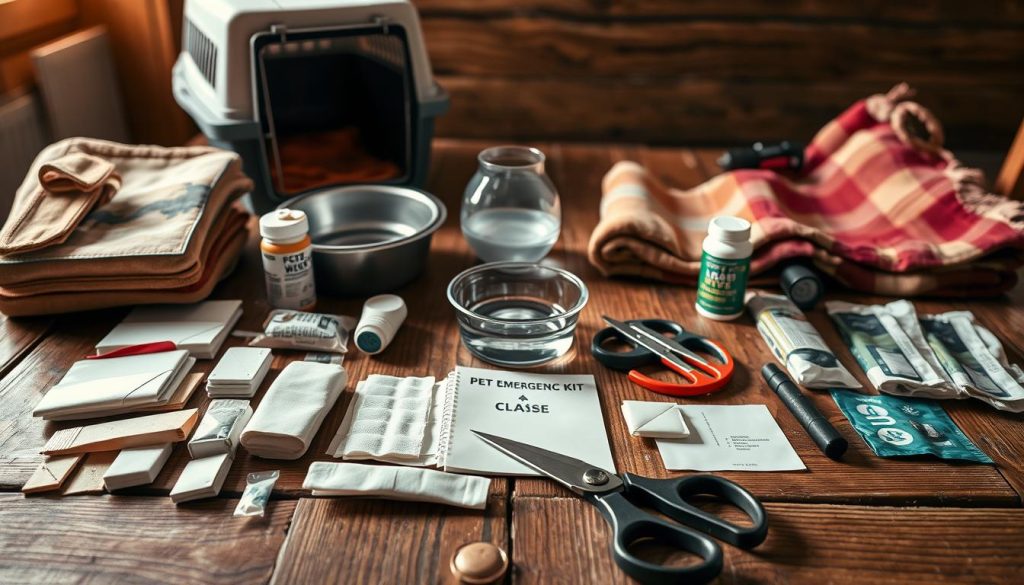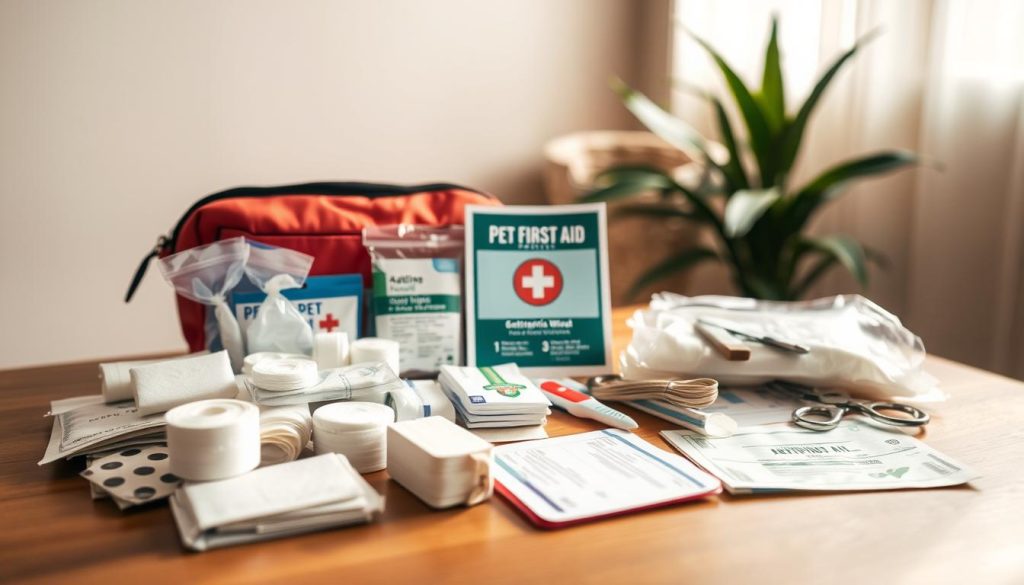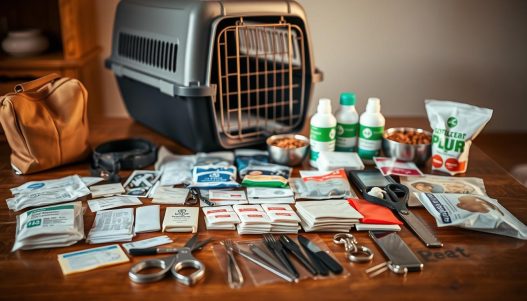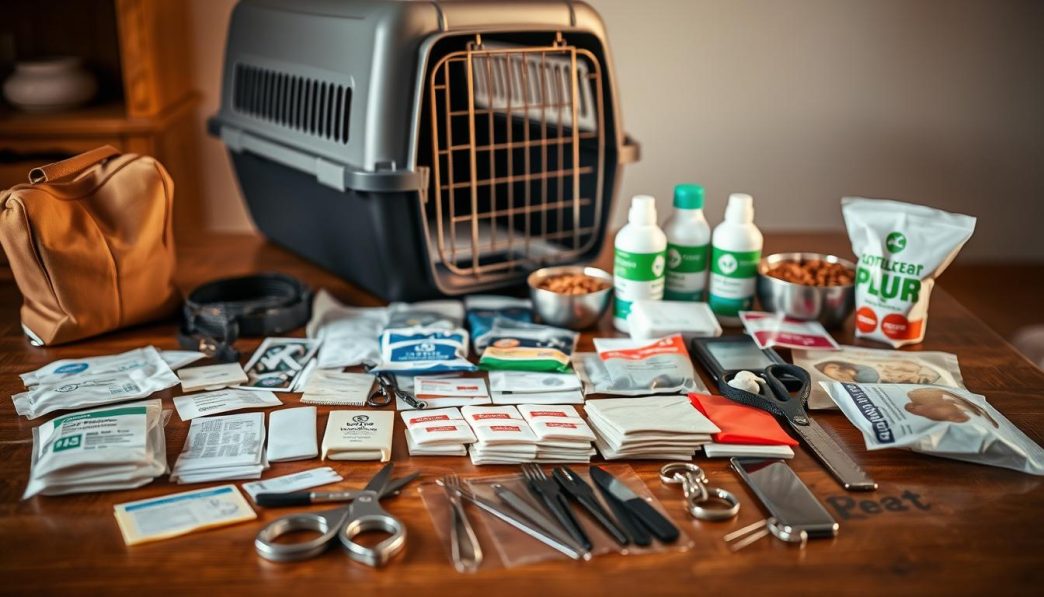As a responsible pet owner, being prepared for unexpected emergencies is crucial for your pet’s safety. Disasters can strike at any moment, and having a well-stocked pet emergency kit can make all the difference in ensuring your furry friend’s well-being.
Having a comprehensive emergency kit is a vital aspect of emergency preparedness. It allows you to respond effectively in critical situations, providing your pet with the necessary supplies to stay safe and healthy.
Key Takeaways
- Understand the importance of having a pet emergency kit.
- Learn what essentials to include in your kit.
- Discover how to prepare your pet for emergencies.
- Find out how to maintain and update your emergency kit.
- Gain insights into ensuring your pet’s safety during disasters.
Why Every Pet Owner Needs an Emergency Kit
Having an emergency kit for your pet is no longer a suggestion, but a necessity. Emergencies can arise from various sources, including natural disasters, accidents, and health crises. Being prepared with the right supplies and knowledge can make a significant difference in your pet’s safety and well-being.
Common Emergency Scenarios
Pet owners should be prepared for a range of emergency scenarios. Natural disasters such as hurricanes, earthquakes, and floods can force you and your pet to evacuate quickly. Other emergencies might include power outages, which can affect your pet’s comfort and safety, or medical emergencies that require immediate attention.
| Emergency Type | Potential Risks | Preparation Tips |
|---|---|---|
| Natural Disasters | Evacuation, injury, loss | Create evacuation plan, stock emergency kit |
| Power Outages | Discomfort, safety risks | Have backup power sources, keep flashlights handy |
| Medical Emergencies | Injury, illness | Keep pet first aid kit, know basic first aid |
The Peace of Mind Factor
Having a pet emergency kit not only prepares you for potential emergencies but also provides peace of mind. Knowing that you have the necessary supplies to care for your pet during a crisis can reduce stress and allow you to focus on your pet’s needs. This preparedness is a crucial aspect of disaster planning and pet care.
By understanding the importance of emergency preparedness and having the right emergency kit essentials, pet owners can take proactive steps to ensure their pets’ safety. This includes being aware of potential emergencies and having a plan in place.
Essential Components of a Pet Emergency Kit
In the face of emergencies, having a comprehensive pet emergency kit can make a significant difference in the well-being of your pets. A well-assembled kit ensures that you are prepared to provide for your pet’s needs, even when circumstances are challenging.
Food and Water Supplies
A crucial aspect of your pet emergency kit is the inclusion of adequate food and water supplies. It’s recommended to store at least a week’s worth of food and water for each pet. Non-perishable food items are ideal, as they can withstand various environmental conditions. Don’t forget to include manual can openers if you’re storing canned food.
Medications and Medical Records
Ensuring that your pet’s medical needs are met during an emergency is vital. Store a sufficient supply of your pet’s prescription medications and keep them in a waterproof container. Additionally, include copies of your pet’s medical records, which can be invaluable if you need to seek veterinary care.
First Aid Supplies
A first aid kit tailored to your pet’s needs is an indispensable component of your pet emergency kit. Include items such as bandages, antiseptic wipes, and tweezers. It’s also beneficial to have a first aid guide specifically designed for pets, to help you navigate common injuries and conditions.
By focusing on these essential components, you can create a comprehensive pet emergency kit that will help safeguard your pet’s health and well-being during emergencies.
Creating a Pet Emergency Kit: What Every Owner Needs
As a responsible pet owner, preparing a pet emergency kit is a proactive measure to safeguard your pet’s well-being during crises. A well-assembled kit ensures that you are equipped to handle various emergency scenarios, providing your pet with the necessary care and supplies.
Basic Kit Assembly Instructions
To assemble a comprehensive pet emergency kit, start by gathering essential items. These include food and water supplies, medications and medical records, and first aid supplies. It’s crucial to consider your pet’s specific needs, such as dietary requirements, medical conditions, and comfort items.
- Store at least a week’s supply of your pet’s regular food and water.
- Include any prescription medications and a copy of your pet’s medical records.
- Add a first aid kit specifically designed for pets, including items like bandages, antiseptic wipes, and tweezers.

Storage Considerations
Proper storage of your pet emergency kit is vital to ensure that it remains accessible and usable during an emergency. Choose a cool, dry location that is easily accessible to all family members. Consider using a clearly labeled container or bag to store your kit’s supplies, making it easy to identify and grab when needed.
It’s also important to store the kit in a location that is protected from potential hazards, such as flooding or extreme temperatures.
Portability Factors
In the event of an evacuation, it’s essential that your pet emergency kit is portable and easy to transport. Consider using a backpack or duffel bag that can be easily carried. Ensure that the kit is not too heavy or bulky, making it manageable for you to take with you and your pet during an emergency.
By considering these factors and assembling a comprehensive pet emergency kit, you can ensure that you and your pet are better prepared to face unexpected emergencies and disasters.
Pet Identification and Tracking in Emergencies
Pet identification and tracking are crucial during emergencies, ensuring your pet’s safety and your peace of mind. When disasters strike, pets can easily become lost or separated from their owners. Having the right identification measures in place can significantly increase the chances of a successful reunion.
ID Tags and Microchipping
The first line of defense in pet identification is using ID tags and microchipping. ID tags should be durable and clearly display your pet’s name and your contact information. Microchipping involves implanting a small chip under your pet’s skin, which contains a unique identifier that can be read by a scanner. This method is particularly effective as it provides a permanent form of identification that cannot be lost or removed.
Digital and Physical Documentation
In addition to ID tags and microchipping, maintaining both digital and physical documentation is vital. Digital documentation can include scanned copies of your pet’s vaccination records, microchip information, and recent photos stored securely online. Physical documentation involves keeping hard copies of these documents in your pet emergency kit. This dual approach ensures that you have access to critical information even if you’re unable to access your digital files.
Recent Photos and Descriptions
Having recent photos and detailed descriptions of your pet can also aid in identification. Photos should clearly show your pet’s appearance, including any distinctive markings or features. Descriptions should include information about your pet’s size, breed, color, and any unique characteristics. This information can be invaluable if your pet becomes lost and needs to be identified.
By implementing these identification and tracking measures, you can significantly enhance your pet’s chances of being safely returned to you during an emergency.
Customizing Your Kit for Different Pets
Different pets have different needs, and understanding these differences is key to creating an effective emergency kit. Whether you have a dog, cat, small mammal, bird, or reptile, tailoring your kit to meet their specific requirements can make a significant difference in emergency situations.
Dog-Specific Needs
Dogs require specific items in their emergency kit, including extra leashes, muzzles, and comfort items like favorite toys or blankets. It’s also essential to include a sufficient supply of their regular food and any prescribed medications. For larger dogs, consider including a portable crate or carrier to help keep them calm and secure during evacuations.
Cat-Specific Needs
Cats have unique needs that should be addressed in their emergency kit. This includes a safe and comfortable carrier, a litter box and litter, and a supply of their regular food and water. Don’t forget to include any necessary medications and a few familiar items like toys or bedding to reduce stress.
Small Mammals, Birds, and Reptiles
For smaller pets like mammals, birds, and reptiles, it’s crucial to include habitat-specific items in their emergency kit. For example, small mammals may require a portable cage with hiding places and a supply of food and bedding. Birds need a safe carrier with perches and a cover to reduce stress. Reptiles require a secure, ventilated container with a heat source if necessary, along with a supply of their specific dietary needs.
By understanding and addressing the unique needs of your pets, you can create a comprehensive emergency kit that will help keep them safe during unexpected events. Regularly check and update your kit to ensure it remains relevant and effective.
Medical Essentials and First Aid Procedures
Emergencies can happen anytime, and being prepared with the right medical essentials and first aid knowledge is crucial for pet owners. Having a well-stocked pet emergency kit and understanding how to use its contents can significantly improve your pet’s chances of receiving the care they need during a crisis.

Treating Common Injuries
Common injuries such as cuts, burns, or broken limbs require immediate attention. For minor cuts, cleaning the wound with saline solution and applying a bandage can help prevent infection. For burns, applying a cool compress can help reduce the temperature of the skin. However, for severe injuries, it’s crucial to seek veterinary care immediately.
First aid kits should include supplies like bandages, antiseptic wipes, and tweezers. Knowing how to apply these supplies effectively is just as important as having them.
Managing Chronic Conditions During Emergencies
Pets with chronic conditions require special consideration during emergencies. Ensuring that you have an adequate supply of your pet’s medication is vital. Additionally, keeping a record of your pet’s medical history, including any allergies and conditions, can be invaluable to emergency responders.
It’s also a good idea to have a portable medical record that you can take with you if you need to evacuate. This can help ensure that your pet receives the appropriate care even if you’re not present.
When to Seek Immediate Veterinary Care
Knowing when to seek immediate veterinary care is critical. Signs that your pet needs urgent care include difficulty breathing, severe bleeding, or signs of extreme pain. If you’re unsure about the severity of your pet’s condition, it’s always best to err on the side of caution and consult with a veterinarian.
By being prepared and knowing how to respond, you can help ensure your pet’s safety during emergencies. Regularly reviewing and updating your emergency kit and knowledge can make a significant difference in your pet’s well-being.
Evacuation Planning with Pets
Evacuation planning is not just about saving human lives; it’s equally important to ensure the safety of our pets during emergencies. A well-thought-out plan can make all the difference in keeping your pets safe and secure.
Pet-Friendly Evacuation Routes and Shelters
When planning your evacuation route, it’s crucial to identify pet-friendly shelters and hotels along the way. Not all emergency shelters allow pets, so it’s vital to research and map out options in advance. Many organizations provide lists of pet-friendly hotels and shelters that can be lifesavers during an evacuation.
| Location | Pet Policy | Contact Information |
|---|---|---|
| Red Cross Shelter | Pets allowed with restrictions | 1-800-RED-CROSS |
| Pet Friendly Hotel | Pets welcome | 1-888-PET-STAY |
Transportation Considerations
Transporting pets during an evacuation requires careful planning. Ensure your vehicle is pet-ready with a carrier or harness to keep your pet safe. Don’t forget to pack your pet’s emergency kit, including food, water, and any necessary medication. For those without a vehicle, identify pet-friendly transportation services in your area.
Temporary Housing Options
After evacuating, finding temporary housing that accommodates pets can be challenging. Research pet-friendly hotels, vacation rentals, or friend/family homes that can provide a safe haven. Always check the pet policy before making a reservation, including any size or breed restrictions.
By considering these factors and planning ahead, pet owners can ensure a smoother evacuation process for both themselves and their pets. Preparation is key to keeping your pets safe during emergencies.
Maintaining and Updating Your Pet Emergency Kit
The effectiveness of a pet emergency kit hinges on its maintenance and regular updates. As emergency preparedness is key to keeping your pet safe, it’s crucial to ensure your kit is always ready for use.
“A well-maintained emergency kit can be the difference between life and death for your pet,” says the American Society for the Prevention of Cruelty to Animals (ASPCA). This emphasizes the importance of regularly checking and updating your pet’s emergency supplies.
Seasonal Updates and Checks
Seasonal updates are vital to ensure your pet emergency kit remains relevant and effective. Check your kit at the start of each season to ensure that all items are still usable and not expired. For example, during winter, ensure that your kit includes warm blankets and that your pet’s medications are not frozen.
Replacing Expired Items
Expired items in your pet emergency kit can be useless when you need them most. Regularly check expiration dates of food, water, medications, and other supplies, replacing them as necessary. This ensures that your kit is always stocked with usable items.
Practice Drills with Your Pet
Having a pet emergency kit is not enough; you and your pet need to be prepared to use it effectively. Conduct regular drills with your pet to ensure they are comfortable with the kit and understand what to do in an emergency. This can include practicing evacuation routes and getting your pet accustomed to wearing their emergency gear.
By following these steps, you can ensure that your pet emergency kit is always ready to help keep your pet safe during emergencies.
Conclusion
Creating a pet emergency kit is a crucial step in ensuring your pet’s safety and well-being during unexpected events. By assembling a well-stocked kit, you can provide your pet with the necessary supplies to navigate emergencies.
As discussed in the previous sections, a pet emergency kit should include essential items such as food, water, medications, and first aid supplies. Customizing your kit according to your pet’s specific needs is also vital.
By prioritizing pet safety and emergency preparedness, you can minimize risks and ensure your pet’s health during crises. A pet emergency kit is a vital tool in this preparation, providing you with the confidence to handle unexpected situations.
Take proactive steps today to prepare your pet for emergencies. Review and update your kit regularly to ensure it remains relevant and effective.






